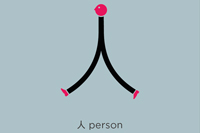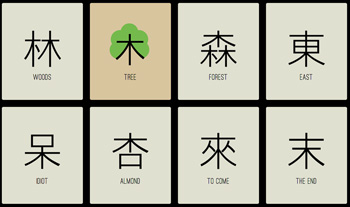print Print...
 (by Olivia Solon, Wired.co.uk) – Entrepreneur and venture capitalist ShaoLan Hsueh has developed a simple methodology — called Chineasy — to allow non-Chinese readers to learn written Chinese characters.
(by Olivia Solon, Wired.co.uk) – Entrepreneur and venture capitalist ShaoLan Hsueh has developed a simple methodology — called Chineasy — to allow non-Chinese readers to learn written Chinese characters.
Chineasy — which aims to “penetrate the Great Wall of Chinese Language” — works by taking a few core characters from the Chinese language and using illustrations and simple stories to help people memorize their meaning. Once people can recognize these characters, it is easy to recognize a family of related characters. For example, the character for the word “tree” has similar visual characteristics to “woods”, “forest”, “idiot” and “almond”. Meanwhile the character for the word “fire” is similar — give or take a few additional pen strokes — or is visible within the characters that mean “hot”, “burning”, “stir fry” and “to head up.”

Starting with eight core characters — fire, tree, Sun, Moon, person, mouth, door, mountain — students can learn 64 different words and combine them to create simple sentences. “My methodology breaks down several thousand characters to identify the fundamental element behind each character. I have combined that with a set of beautiful graphics that allow people to recognize patterns and therefore the meaning of symbols very quickly,” Hsueh told Wired.co.uk.
Hsueh grew up in Taiwan and is the daughter of a calligrapher and a professor of ceramic art. She has always been fascinated by the beauty of Chinese characters, but appreciates how impenetrable the language can be to foreigners. She moved to the UK more than a decade ago and has two children, but became “really frustrated that they couldn’t read Chinese.”

This triggered her to try and find an easier way to teach the language. “The kids love it. They have been going to a Chinese club but they learn nothing. No one will learn from that curriculum,” she explained.
“It’s a hobby that has developed into a methodology, using characters, animations and colors,” she added. Hsueh partnered with illustrator Noma Bar to bring the first characters to life, but has plans to work with other illustrators as she develops the methodology.
Hsueh presented Chineasy in an eight minute TED talk in February. This was then written up by Idealab’s CEO Bill Gross in a LinkedIn post. ShaoLan says that subsequently she was contacted 8,000 times by people who were interested in the project.
“People look at Chinese and see this Great Wall of China. I want people to understand China, Chinese and Chinese culture without getting lost in translation,” she told Wired.co.uk.
 Hsueh is currently working full-time on the project and plans to launch a new website in June, with more characters and more “tutorials” showing how to use different words. At the same time she is also working on a book.
Hsueh is currently working full-time on the project and plans to launch a new website in June, with more characters and more “tutorials” showing how to use different words. At the same time she is also working on a book.
She explains that a scholar of the Chinese language will master 20,000 characters, but you only need around 1,000 for basic literacy. “What is most intriguing is that if you can learn just the top 200 characters, it is enough to be able to read about forty percent of popular Chinese literature,” she explains on her site. That’s also enough for many practical uses, such as reading road signs and restaurant menus as well as grasping the gist of newspaper articles and websites.”
“For me it’s a legacy. I want to share it with people who want to learn about China,” she concludes.
Hsueh has launched a Facebook page with more information about the initiative.
From Wired.co.uk. Reprinted here for educational purposes only. May not be reproduced on other websites without permission from Wired. Visit the website at wired.co.uk.
Questions
1. What is Chineasy?
2. How does Chineasy work? (How does it teach a person to read basic Chinese?) Be specific.
3. a) Approximately how many characters does an expert of written Chinese learn?
b) How many characters does a person need to learn for basic Chinese literacy?
4. What can a person do if he learns the top 200 characters?
5. Why did Ms. Hsueh develop Chineasy? (What does she hope to achieve with this program?)
CHALLENGE #1: What is the name for the system used to transliterate Chinese words into the Roman Alphabet? (It is the official system to transcribe Chinese characters into Latin script in China, Taiwan, and Singapore.)
CHALLENGE #2: Check out the Chineasy website. Although still a work in progress, does it look like something that would be useful to most people attempting to learn basic Chinese? Explain your answer.
Resources
Visit Ms Hseuh’s website at: chineasy.org.
Visit Chineasy’s facebook page at: facebook.com/ShaoLanChineasy?ref=tn_tnmn.
Daily “Answers” emails are provided for Daily News Articles, Tuesday’s World Events and Friday’s News Quiz.



